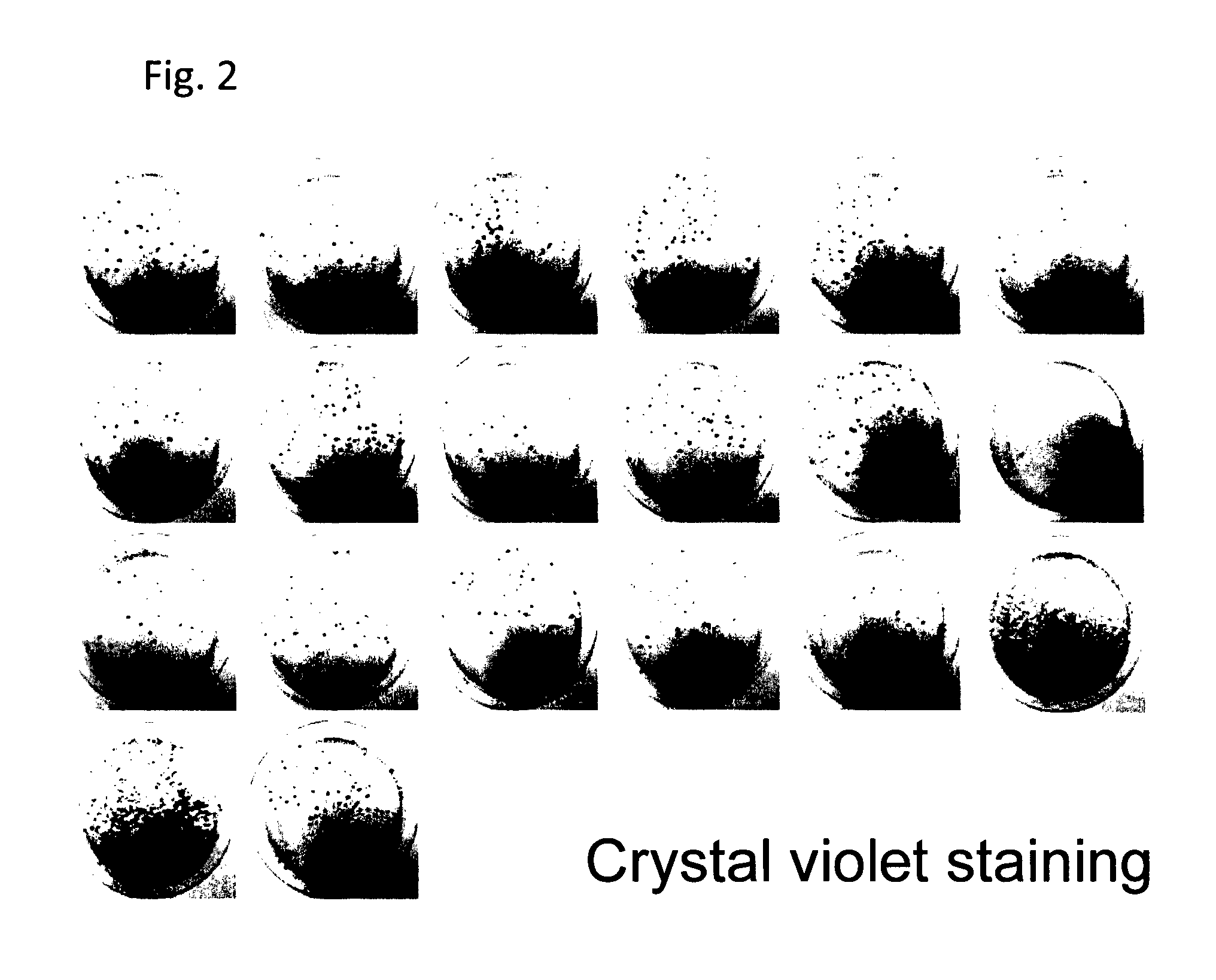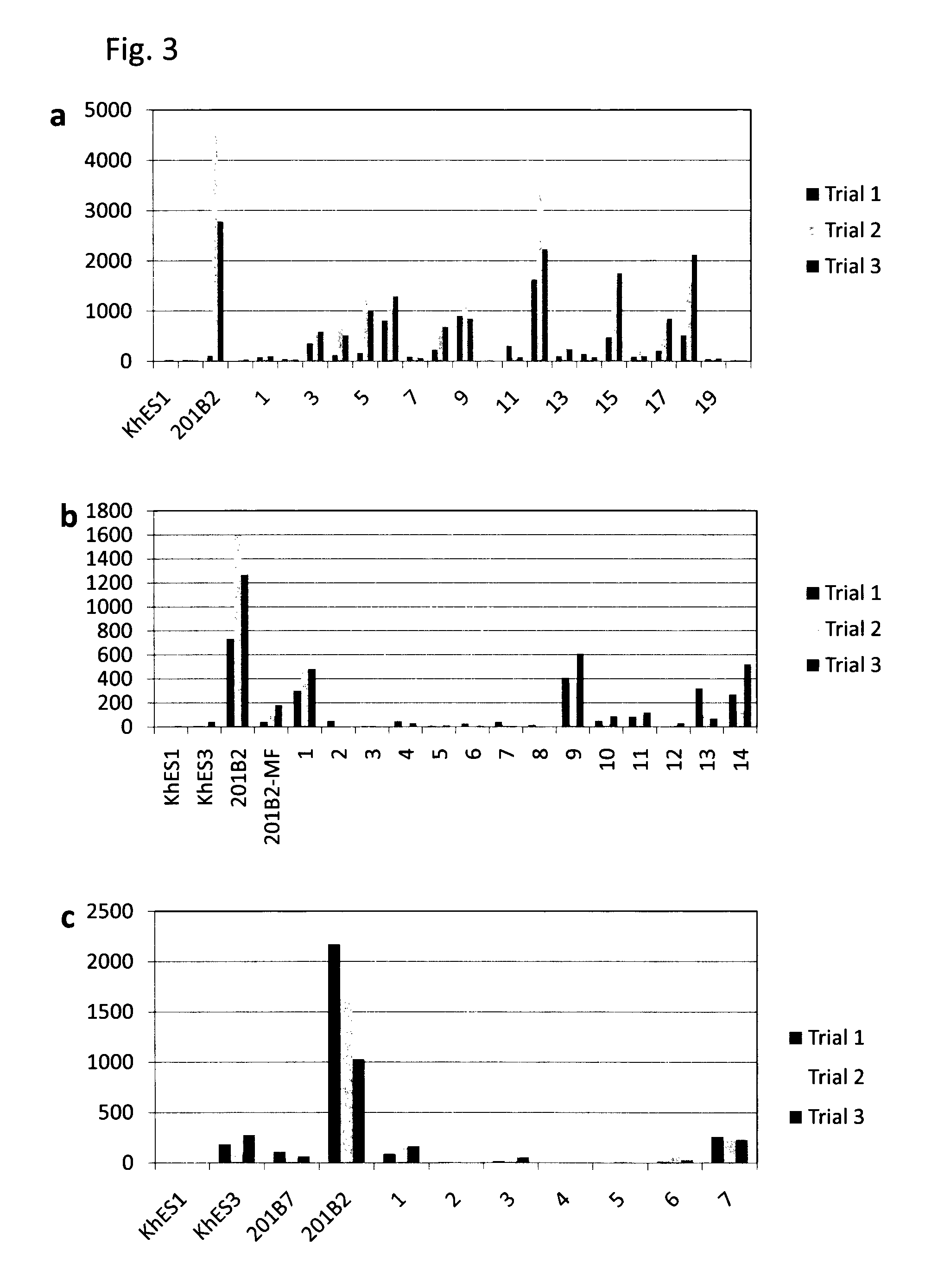Method for selecting human induced pluripotent stem cells
a human induced pluripotent stem and cell technology, applied in cell culture active agents, instruments, biochemical apparatus and processes, etc., can solve problems such as tumor formation, and achieve the effect of maintaining pluripotency and efficient selection of human ips cells
- Summary
- Abstract
- Description
- Claims
- Application Information
AI Technical Summary
Benefits of technology
Problems solved by technology
Method used
Image
Examples
example i
Cells
[0055]Human ES cells (KhES-1 and KhES-3) were received from Institute for Frontier Medical Sciences, Kyoto University, and cultured by a conventional method (Suemori H, et al. Biochem Biophys Res Commun. 345:926-32, 2006).
[0056]Human iPS cells were prepared from fibroblasts or dental pulp stem cells using 4 factors (OCT3 / 4, SOX2, KLF4 and c-MYC) or 3 factors (OCT3 / 4, SOX2 and KLF4) by conventional methods (Takahashi K, et al. Cell. 131:861-72, 2007; WO 2009 / 057831; WO 2010 / 013359; Nakagawa M, et al. Nat Biotechnol. 26:101-6, 2008). In the four-factor method, 22 lines of iPS cells such as 201B2 and 201B7 were used. In the three-factor method, 14 lines of iPS cells were used. By investigating the karyotypes of 201B2 and 201B7, it was confirmed that 201B2 shows trisomy of chromosome 12. On the other hand, the karyotype of 201B7 was normal. Among subclones of 201B2, 201B2-MF was established as a clone having the normal karyotype.
[0057]In terms of iPS cells derived from human ES cel...
example ii
Cells
[0083]KhES-1, KhES-3 (Suemori H, et al. Biochem Biophys Res Commun. 345:926-32, 2006) and H9 (Thomson, J. A., et al., Science 282 : 1145-1147, 1998) were used as human ES cells.
[0084]The human iPS clones (CB-RV4F-2, DP-EP6F-1, FB-RV3F-4 and FB-RV4F-5) which resisted inducing neural differentiation by modified SFEBq method were subcloned into 15 clones, 15 clones, 10 clones and 12 clones, respectively (see table 6 to 9).
Measurement of Content Rate of Undifferentiated Cells
[0085]The neural cells which were produced with above modified SFEBq method from said subclones, parent clones or ES cell lines were dissociated and immunostained with TRA-1-60 antibody. Then, the content rate of TRA-1-60 positive cells was analyzed with flow cytometry. The result is shown in Table 6 to 9 and FIG. 5a to d. From the above results, it was revealed that 16 subclones could be selected as the clones with low differentiation resistance.
TABLE 6TRA-1-60 positive cells (%)subclone name1st try2nd try3rd ...
PUM
| Property | Measurement | Unit |
|---|---|---|
| differentiation resistance | aaaaa | aaaaa |
| permeable | aaaaa | aaaaa |
| drug resistance | aaaaa | aaaaa |
Abstract
Description
Claims
Application Information
 Login to View More
Login to View More - R&D
- Intellectual Property
- Life Sciences
- Materials
- Tech Scout
- Unparalleled Data Quality
- Higher Quality Content
- 60% Fewer Hallucinations
Browse by: Latest US Patents, China's latest patents, Technical Efficacy Thesaurus, Application Domain, Technology Topic, Popular Technical Reports.
© 2025 PatSnap. All rights reserved.Legal|Privacy policy|Modern Slavery Act Transparency Statement|Sitemap|About US| Contact US: help@patsnap.com



